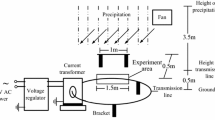Abstract
Insulator icing flashover has always been one of the important factors influencing the safety of power grids in winter. Due to the limitation of tower structure and distance between the conductor and the ground, the existing anti-icing flashover method has certain effects but still cannot fully meet the safety requirements of power grids. Based on the idea of changing the ice coverage and discharge path of insulator string, a brand-new insulator string that arranged as inverted T-type is proposed in this paper to achieve the purpose of reducing ice coating and increasing the ice flashover voltage. The icing and flashover experiments are simulated in an artificial climate room. The experiment results show that the ice amount of inverted T-type insulator is smaller than that of the same type and same creepage distance of suspension I-string, and the inclined portion of the inverted T-type arrangement is basically free from bridges under glaze and mixed-phase ice conditions. In the case of the same creepage distance, dry-arc distance, the same degree of contamination, and the ice-covering condition of the same type of insulator, the melting flashover voltage gradient E50 of the inverted T-type string is 14.8–16.3% higher than that of the suspended I-string. The results show that after the insulator adopts inverted T-type arrangement, the ice coating can be significantly reduced and the ice flashover voltage can be increased. The conclusions of the study provide a new solution for the anti-icing flashover treatment and design of the overhead lines.

















Similar content being viewed by others
References
Farzaneh M, Zhang J, Chen X (1997) Modeling of the AC arc discharge on ice surfaces. IEEE Trans Power Deliv 12(1):325–338
Farzaneh M, Chisholm W (2009) Insulators for icing and polluted environments. Wiley, Hoboken
Chameski MD (1982) Flashover tests of artificially insulator. IEEE Trans 8:2429–2433
Xingliang Jiang, Hui Yi (2002) Transmission line icing and protection. China Electric Power Press, Beijing (in Chinese)
Kuroiwa D (1958) Icing and snow accretion. Monogr Ser Res Inst Appl Electr 6:1–30
Xing C (2000) Modeling of electrical arc on polluted ice surface. Ph.d. dissertation, Canada
Farzaneh M, Melo OT (1990) Properties and effect of freezing and winter fog on outline insulators. J Cold Reg Sci Technol 19:33–46
Le WANG, Qiang SUN, Jianqi LIU (2008) Comparative analysis on measures taken by china and other countries to cope with power grid blackouts caused by ice storms. Electr Power Technol Econ 20(2):6–10 (in Chinese)
Jiang X, Zhao J, Luo B, Zhang J, Huang C (2009) Survey and analysis of ice accidents of early 2008 in Southern China. In: IWAIS XIII, Andermatt, September 8–11, 2009
Huang X, Li J, Liu W, Liu J, Song A (2009) A new on-line monitoring system of transmission line icing and snowing. In: IWAIS XIII, Andermatt, September 8–11, 2009
Jiang X, Zhang Z, Hu Q, Hu J, Shu L (2008) Thinkings on the restrike of ice and snow disaster to the power grid. High Vol Eng 44(2):463–469 (in Chinese)
Farzaneh M, Kiernicki J (1997) Flashover performance of IEEE standard insulators under ice conditions. IEEE Transactions on Power Delivery 12(4):1602–1613
Gutman I, Halsan K, and Hü Binette D (2003) Application of ice progressive stress method for selection of insulation options. In: Smit J (ed) Proceedings of 2003 international symposium on high voltage (ISH- 2003), Mill press, Netherlands, Rotterdam, The Nether-lands, p. 179
Zhang Z, Jiang X, Sun C, Hu J, Huang H, Gao DW (2012) Influence of insulator string positioning on AC icing flashover performance[J]. IEEE Trans Dielectr Electr Insul 19(4):1335–1343
Kannus K, Lahti K (2007) Laboratory investigations of the electrical performance of ice-covered insulators and a metal oxide surge arrester. IEEE Trans Dielectr Electr Insul 14(6):1357–1372
Yin F, Jiang X, Farzaneh M, Hu J (2015) Electrical performance of 330-kV composite insulators with different shed configurations under icing conditions[J]. IEEE Trans Dielectr Electr Insul 22(6):3395–3404
Jiang XL, Wang B, Zhang ZJ, Hu JL, Sun CX (2007) Influence of units and assemble on DC flashover voltage of iced insulator strings at high altitude districts. J Chongqing Univ (Nat Sci Ed) 7:37–41
Xiangyang PENG, Senjing YAO, Xianyin MAO, Zhihai XU, Zhidong JIA (2012) Research on electrocaloric effect and ice–water switching principle based anti-icing coating for insulators of overhead transmission lines and its performance. Power Syst Tech-nol 36(7):133–138 (in Chinese)
National Energy Administration of China (2013) DL/T 1244-2013 Artificial icing flashover test methods on high voltage insulators to be used in AC system (in Chinese)
IEC 60507-2013 (2013) Artificial pollution tests on high-voltage ceramic and glass insulators to be used on a.c. systems
Farzaneh M, Baker T, Bemstorf A et al (2003) Insulator icing test methods and procedures: a position paper prepared by the IEEE task force on insulator icing test methods. IEEE Trans Power Deliv 18(4):1503–1515
Author information
Authors and Affiliations
Corresponding author
Additional information
Publisher's Note
Springer Nature remains neutral with regard to jurisdictional claims in published maps and institutional affiliations.
Rights and permissions
About this article
Cite this article
Chao, Y., Huang, F. Preliminary study on icing and flashover characteristics of inverted T-type insulator strings. Electr Eng 101, 675–683 (2019). https://doi.org/10.1007/s00202-019-00816-7
Received:
Accepted:
Published:
Issue Date:
DOI: https://doi.org/10.1007/s00202-019-00816-7




